With SEO, not every strategy involves intense competition or a hefty budget to make a real impact. “Low-hanging fruit” SEO focuses on capturing opportunities that are easier to achieve but still deliver substantial value. From optimizing content that targets “striking distance” keywords to finding search terms your competitors are ranking for, low-hanging fruit strategies help boost your visibility, attract quality traffic, and drive results faster. In this guide, we’ll dive into what low-hanging fruit SEO is and how you can leverage these quick wins to build a strong foundation for long-term growth.
What is Low-Hanging Fruit SEO?
Low-hanging fruit SEO refers to optimization strategies that offer a high potential for engagement and online visibility with minimal effort on your end. These ripe, ready-to-pick SEO tactics can organically increase your site’s traffic and improve your brand’s online presence. The strategies we’ll outline in this article don’t require substantial investment or resources.
While there are several low-hanging fruit SEO opportunities, we’ll be highlighting 3 in this blog:
- Target Low-Hanging Fruit Keywords
- Find Striking Distance Keywords & Optimize Content Surrounding These Phrases
- Analyze What Search Terms Your Local Competitors Are Ranking For
Let’s explore how you can leverage low-hanging fruit SEO for a massive payoff online.
How to Find Low-Hanging Fruit Opportunities for SEO: 3 Techniques
1. Target Low-Hanging Fruit Keywords
One key low-hanging fruit SEO strategy is to find and target keywords (relevant to your business) with decent search volume but low competition. Since these keywords attract a steady amount of search traffic monthly but aren’t highly competitive, they’re easier to rank for and offer significant boosts for your SEO efforts, increasing organic traffic and your site’s positioning on search engine result pages (SERPs).
Here are 3 benefits to targeting low-hanging fruit keywords:
- Easier to rank for and faster results: Low-hanging fruit keywords usually provide quicker results and potentially higher conversion rates due to their relevance to the searcher’s intent. For example, suppose your outdoor company targets “tents” as a keyword. In this case, it would be incredibly difficult for even many very established brands to rank within the top search results even with very large budgets, niche-related and high-quality backlinks, and extensive hard work. However, if you were to target “large 3 season canopy tent,” “2 person pop up tent,” or “large lightweight backpacking tents,” you’ll find it much easier to start ranking for these keywords at a quicker rate since they maintain high search volume but with lower competition. While these long-tail keywords may generate less traffic overall, they’ll attract more targeted customers who are ready to buy your products and efficiently move through the sales funnel.
- Boosted online user engagement: Low-hanging fruit keywords are often highly specific search queries from users looking for a particular service, product, or answer. When you target these keywords throughout your site, you’re more likely to attract a more specific audience that will engage with your content, resulting in better search results rankings and enhanced favor with Google.
- Lower risk required—but with high payoff potential: Focusing on low-hanging fruit keywords is much lower risk than targeting broader head keywords, resulting in numerous benefits for your business. One of the primary rewards of targeting low-hanging fruit search terms is the lower investment required. Head keywords are highly competitive to rank for and demand an extensive amount of time, money, and effort to achieve the results you’re looking for. On the other hand, low-hanging fruit keywords have lower competition, making it easier to increase online visibility on a smaller budget and often with quicker results. A primary advantage of targeting these long-tail search terms is that they provide an attainable path to improving rankings promptly and successfully. Unlike head keywords, which require competing with large websites boasting massive authority and extensive resources, low-hanging fruit keywords offer a more targeted approach to drive relevant traffic, ultimately leading to better engagement and higher conversion rates. Ranking for these terms also sets you up to compete for more sought-after terms down the line!
How to Find Low-Hanging Fruit Keywords on Semrush
Tools like Semrush, Ahrefs, and Google Search Console can help you find low-hanging fruit keywords for your business. If you’re new to SEO keyword research, here’s a step-by-step process to discovering low-hanging fruit search terms on Semrush for your SEO strategy:
Build a Keyword List
First, you’ll start by making an initial keyword list. Consider what your target audience would search for online to find your business and build a list surrounding these keywords. For example, if you own an outdoor clothing and gear store, you may target search terms such as:
- womens down jacket
- mens hooded vest
- waterproof hiking backpack
- hiking pants mens
- winter jacket mens
- daypacks for hiking
- running pack vest
If you’re having trouble knowing what online users would be searching for when it comes to your business, you can utilize AI tools like ChatGPT to brainstorm a list of initial search phrases. As you create an initial keyword list, plug the phrases into Semrush’s Keyword Overview tool to measure each search term’s performance, search volume, and keyword difficulty (KD%). Keyword difficulty helps you determine the difficulty of competing for this keyword if you’re starting from scratch with SEO efforts (we’ll discuss KD% and other performance measures more in-depth later).
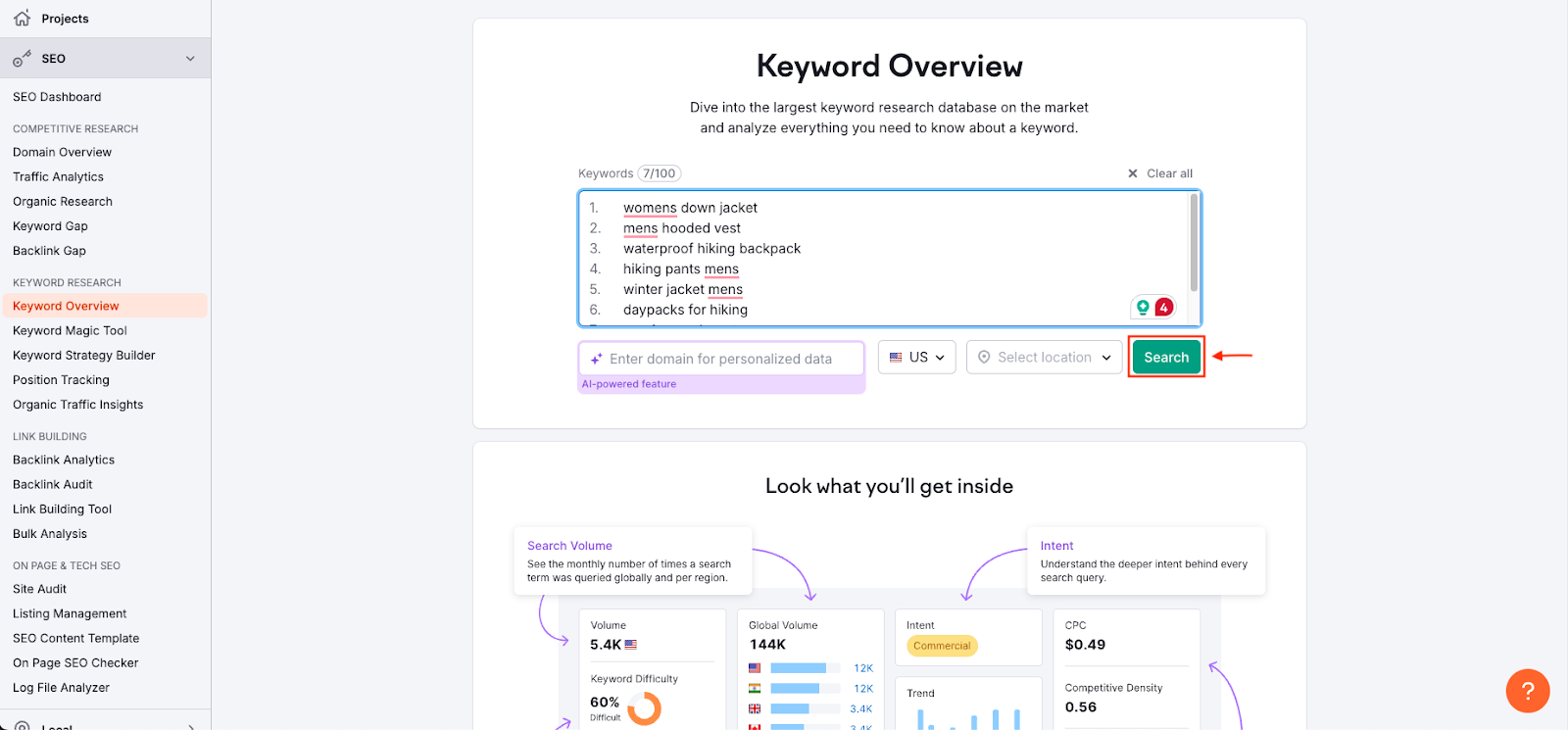
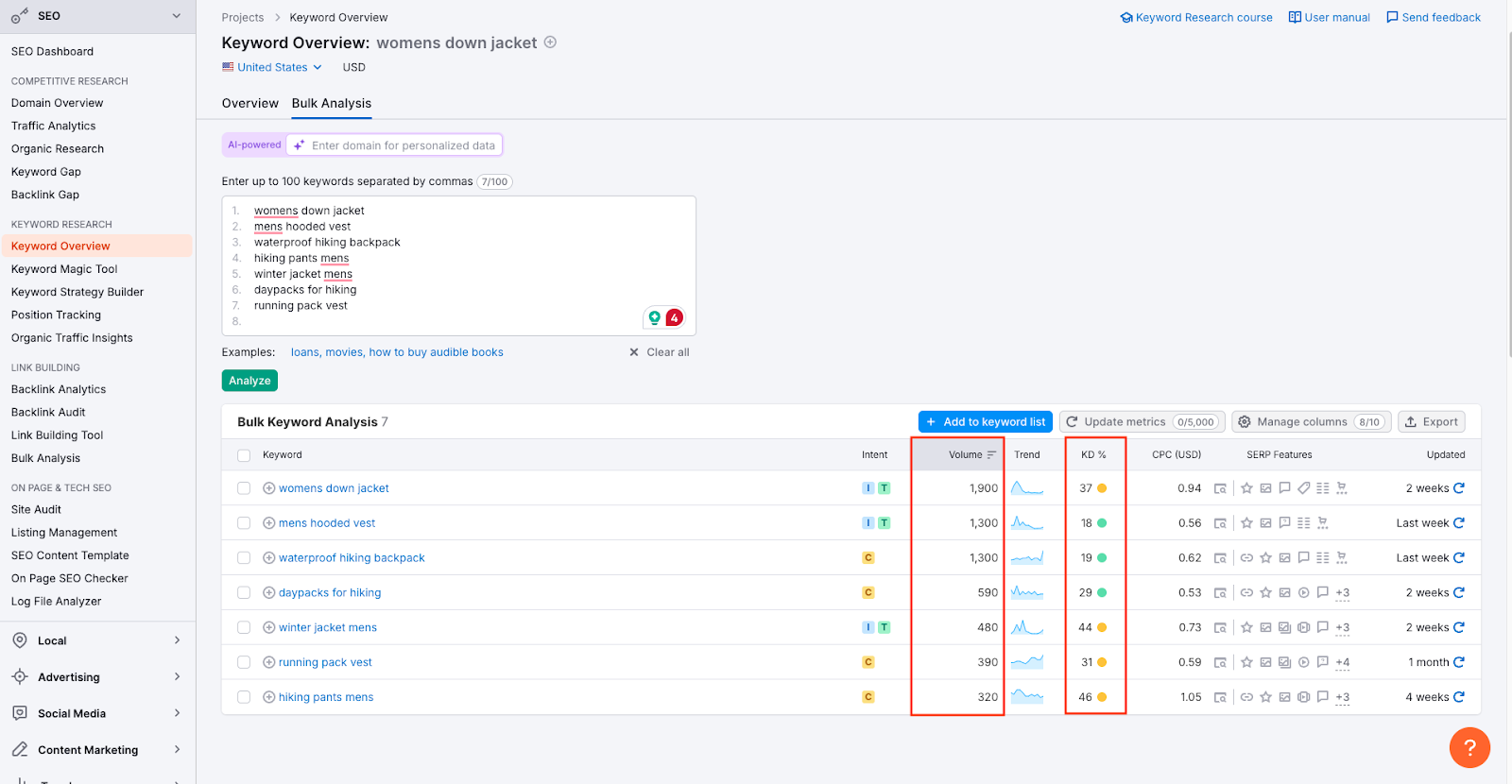
As you determine which keywords you’d like to target on your site, send them to Semrush’s Keyword Strategy Builder, where you can save up to 1000 search terms.
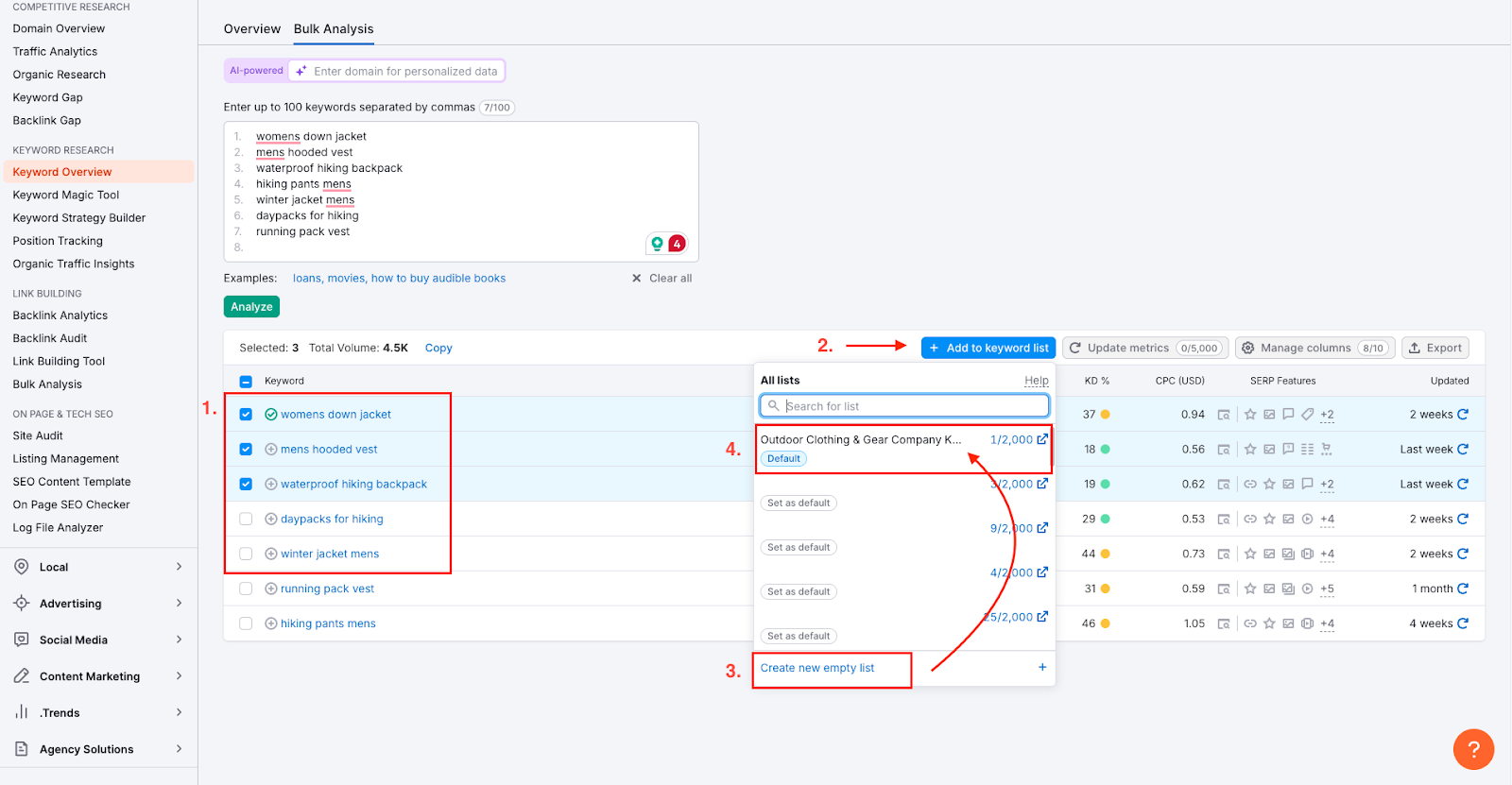
Use Semrush’s Keyword Magic Tool to Find High Search Volume, Low-Competition Keywords
Once you’ve established an initial set of keywords, it’s time to expand the list with more low-hanging fruit phrases. There are 2 filters you should consider when looking for low-hanging fruit search terms on Semrush:
KD%: Keyword difficulty estimates how challenging it would be to organically outrank the current sites and web pages ranking in the top search results for a specific keyword. When searching for low-hanging fruit keywords, target phrases with a keyword difficulty of 30% or less to start. If your site has some authority built already, you may be able to pursue slightly more competitive terms. Search terms with a higher difficulty percentage require the highest-quality content, solid link-building campaigns, and extensive SEO efforts to rank on search engines.
Search Volume: Semrush’s search volume filter is the average monthly searches for a particular keyword over 1 year. Oftentimes, search volume for low-hanging fruit is lower than highly competitive keywords. Although this may be seen as a negative, the traffic from low-hanging fruit keywords is likely more targeted—and you’re likely to rank in the top positions for your search terms since fewer sites compete for them. For example, the search query “running shoes” has over 200K monthly searches (according to Semrush at the time I wrote this article) compared to the term “womens trail running shoes,” which has about 3K searches per month. While the first search phrase attracts more attention monthly, it’s very difficult to rank for the term since it has a high KD% and likely won’t attract the right audience you’re looking for due to its broad intent; the user could be looking for a Wikipedia page on the history of running shoes for all we know. When finding low-hanging fruit keywords, they’ll most likely have a lower monthly search volume, but you’ll benefit from targeted traffic, improved organic rankings, and increased conversion rates.
Semrush’s Keyword Magic Tool effectively expands your search phrase list and presents low-hanging fruit keywords. Using the tool, enter a term from your initial list of keywords and click “Search.” You’ll be given a list of keywords, including your query search phrase. You can click the keyword difficulty filter to find keywords with a low KD% and show the search phrases with the lowest competition.
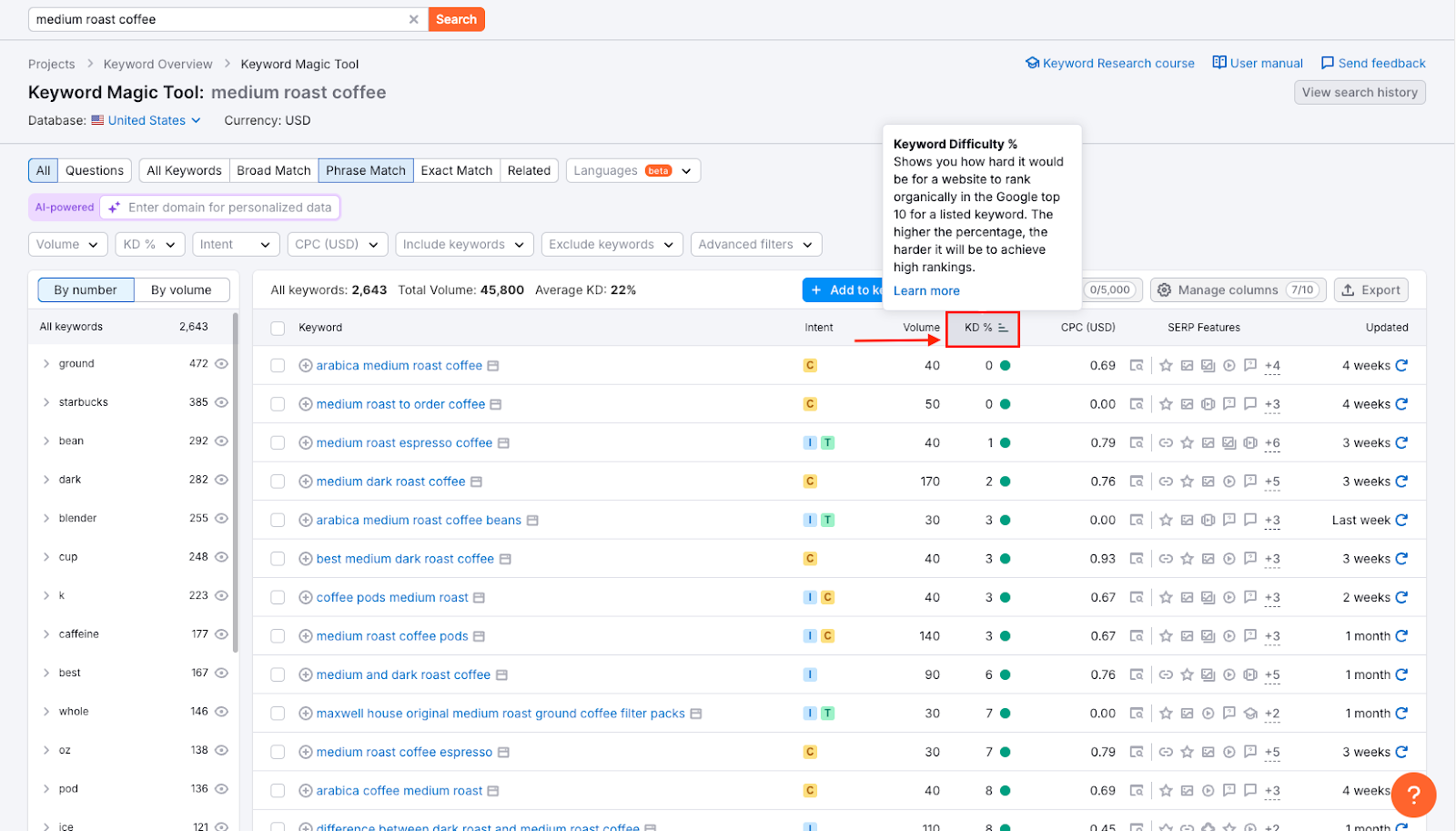
You can also apply a filter to see keywords with a certain KD%, such as search phrases with a keyword difficulty of 0–30%.
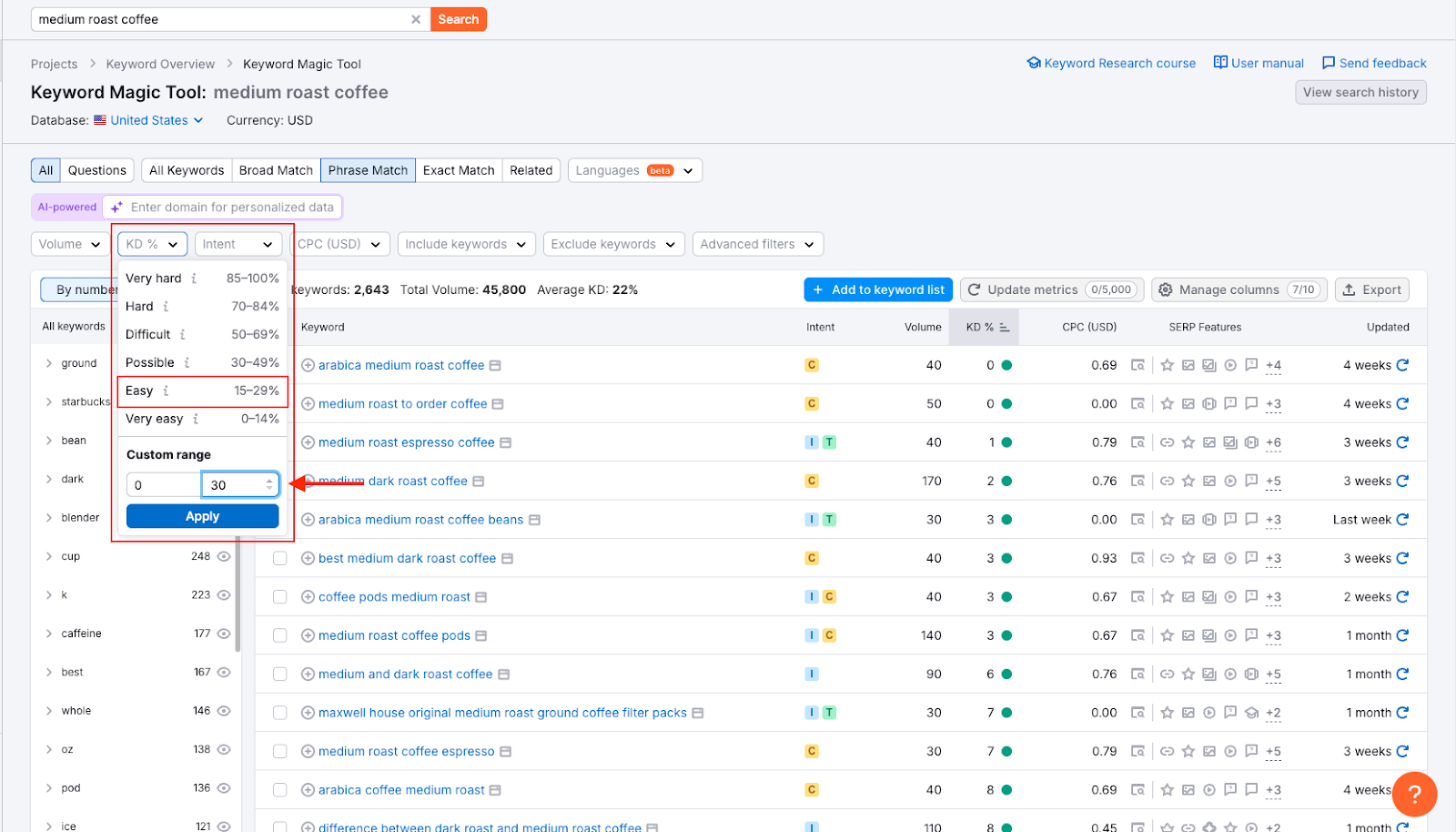
On the Keyword Magic Tool, you can also find question keywords or phrases that may not have the exact phrasing but still attract similar searchers. Add a mix of these terms to your list, finding ones with low keyword difficulty and decent search volume. Some simple math (search volume/KD %) could help you compare terms and determine which keywords you should address first.
2. Find Striking Distance Keywords & Optimize Content Surrounding These Phrases
If your site has been established for a while, a valuable SEO opportunity to leverage is to find and target “striking distance” keywords. These are search terms that your site is already ranking for but in positions that most likely don’t result in clicks or engagement, such as positions 6–25. Striking distance keywords are within your site’s “striking distance” since they’re only a few positions away from the high-yielding top spots on the first page of search results. Different experts define striking distance keywords in various ranges. For example, if you’re targeting a topic with lower competition, you may lower your range to positions 4–20. However, if you’re focusing on competitive keywords, you might raise your range to 8–30.
Why should you target striking distance keywords? Since search engines already associate your domain and site pages with these queries, your chance of ranking higher for them is very likely with some minor SEO adjustments. With striking distance keywords, you already have a head start at ranking for these terms on Google’s first page, driving online traffic to your site and benefiting from beating your competitors.
How to Discover Striking Distance Keywords For Your SEO Efforts
Tools like Semrush, Ahrefs, and Moz can be leveraged to help you find striking distance keywords for your SEO strategy. I’m using Semrush’s Organic Research tool to teach you how to discover striking distance keywords for your site.
Find Striking Distance Keywords on Semrush’s Organic Research tool
Enter your domain name into the Organic Research tool and click “Search.” Then, tap on the “Positions” tab to find which search terms your domain or site pages rank for and their SERP positions. Here’s an example of a tub and sauna dealership in Utah:
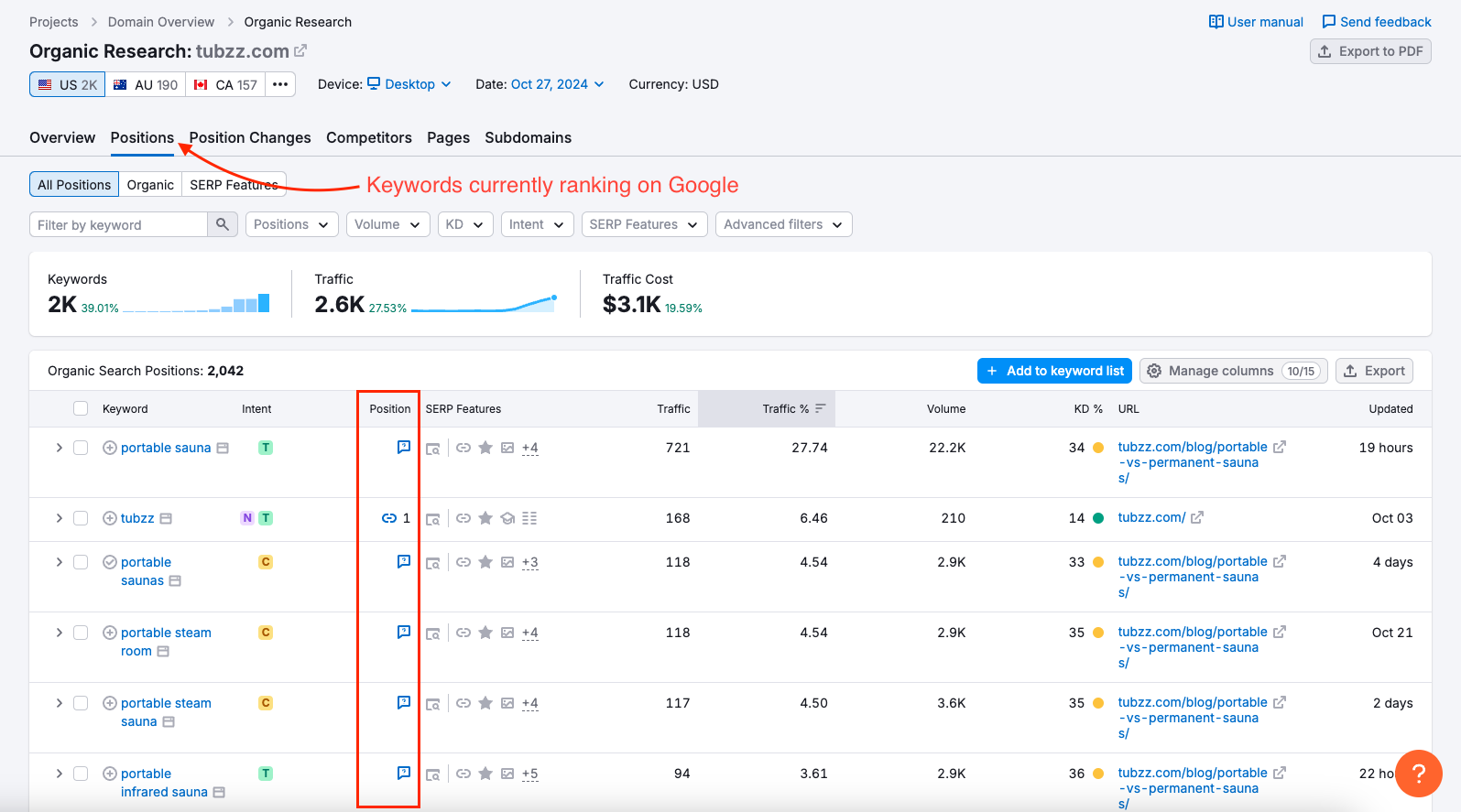
To find striking distance keywords for your SEO efforts, use Semrush’s filters to display keywords ranked in positions #6–20—or even lower, depending on the keyword. You can even add geo-specific terms to display keywords with a commercial intent, which searchers use when they’re ready to make a purchase and can enhance your local SEO strategy. Add a mix of search terms with differing intents to Semrush’s Keyword Strategy Builder to further boost your low-hanging fruit SEO plan of action.
Optimize Your Content & Target Striking Distance Keywords
After identifying your striking distance keywords, optimize your content around these terms. Update your pages to include these keywords naturally in headers, meta titles and descriptions, and throughout the body of your content. Aim to provide comprehensive, engaging, and informative answers that address user intent. Improving user experience on your site is equally important; ensure fast loading times, mobile-friendly design, and easy navigation. These enhancements will make your content more appealing to visitors and help search engines recognize your site as relevant and valuable, boosting your rankings over time.
3. Analyze What Search Terms Your Local Competitors Are Ranking For
Another low-hanging fruit SEO opportunity is to analyze the keywords your local competitors rank for, particularly those with moderate competition that align with your business. By optimizing your website and pages for these terms, you can tap into an existing audience actively searching for similar products or services in your area. Targeting these keywords in headers, meta titles and descriptions, and throughout your content, like blog posts or geo-specific landing pages, can significantly boost your digital marketing efforts. This approach increases your chances of earning higher-ranking positions and capturing local search traffic currently going to your competition.
How to Find What Keywords Your Competitors Are Ranking For
To find what search phrases your competitors are ranking for, you can use resources like Semrush’s Keyword Gap and Organic Research tools. Let’s say you own a multi-location property management company in Southern California. One of your competitors would be a website like truedoorpm.com. Enter their URL into the Organic Research tool, and you’ll find the keywords they’re currently ranking for and earning traffic from.
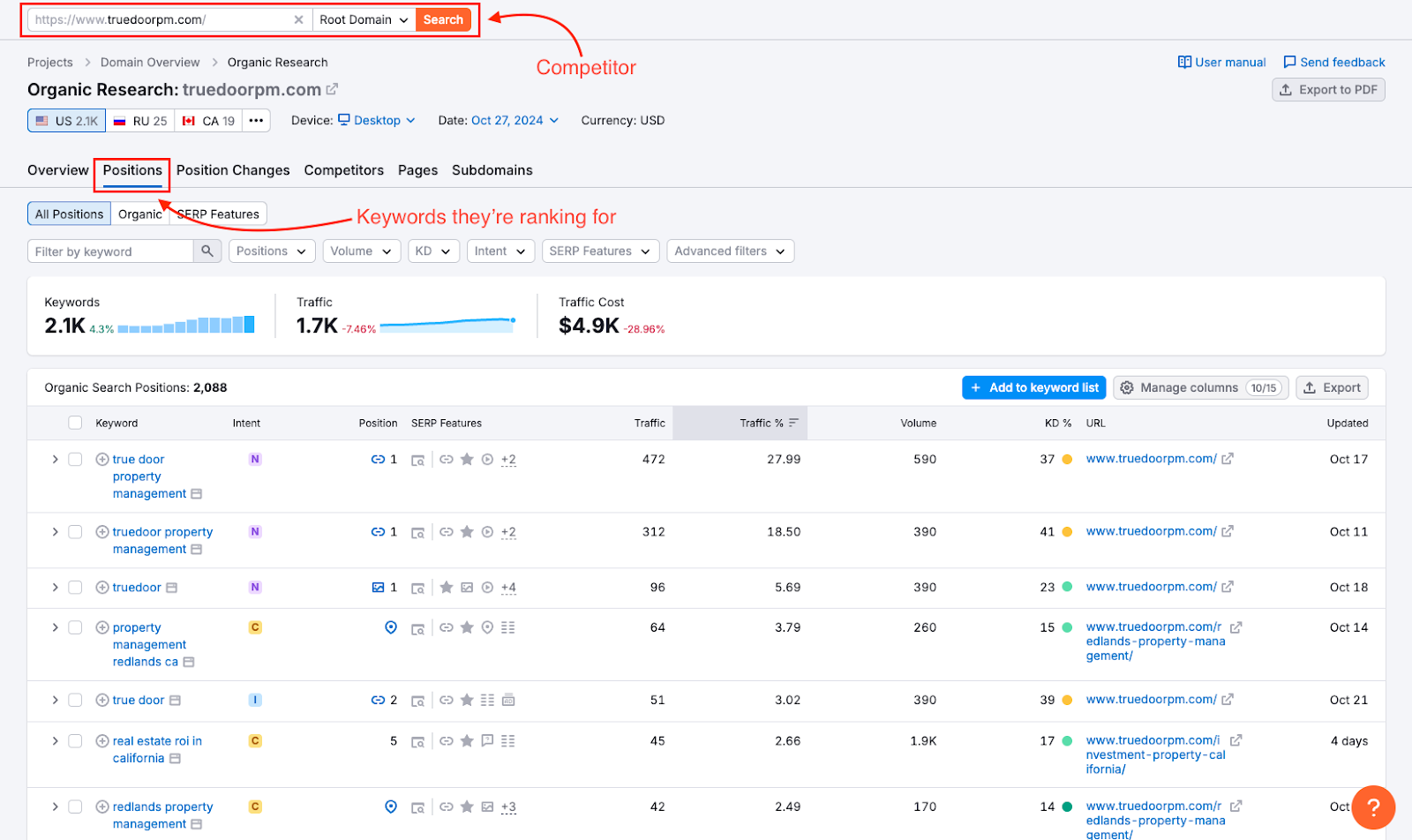
Add a filter to find keywords with commercial intent, which often shows you localized terms that customers use to search for services or products they’re ready to invest in, like your property management solutions.
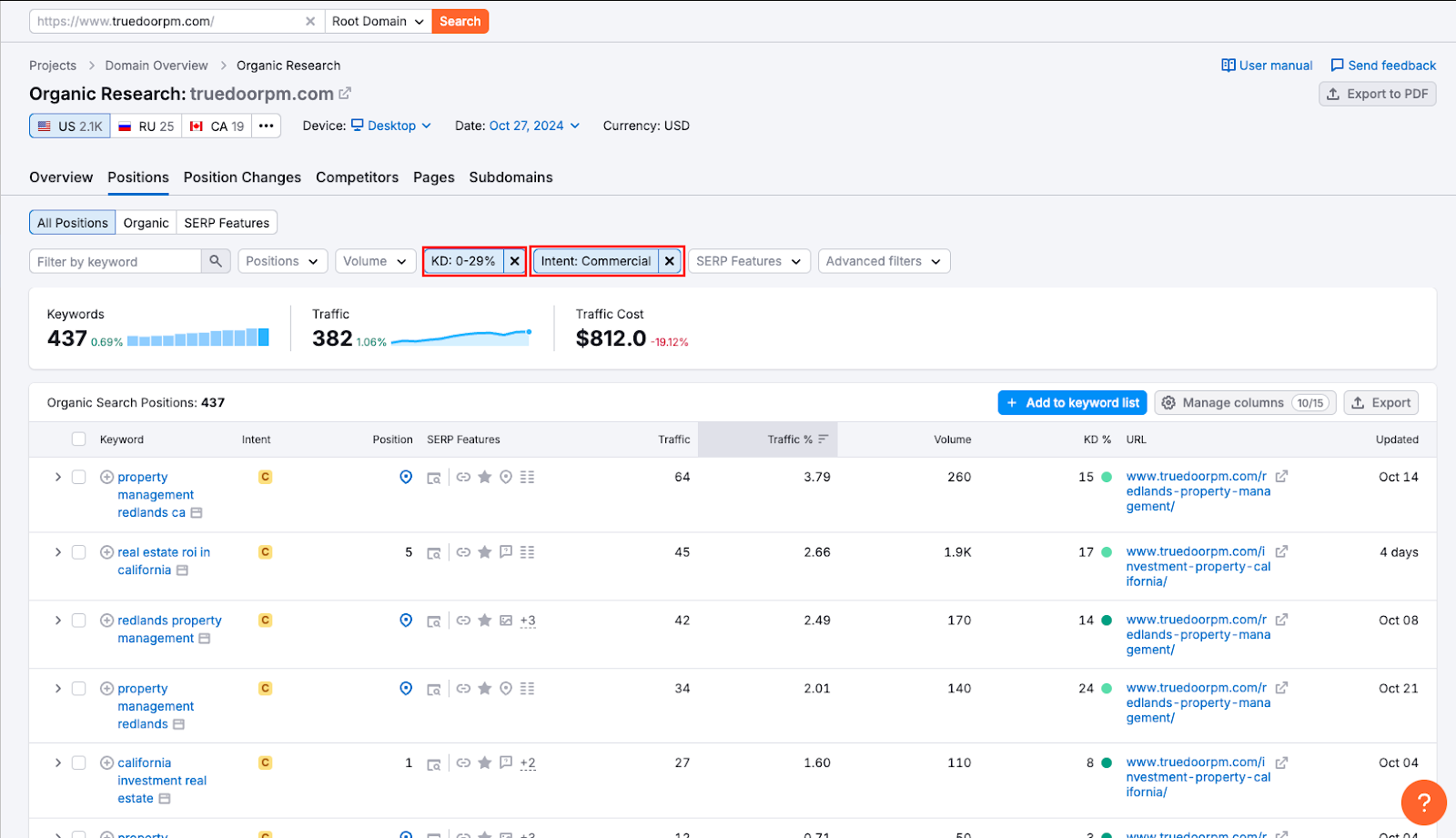
You can also add a keyword difficulty filter or a particular phrase (such as a city or county) to find the low-hanging keyword fruit options. Repeat this process with multiple competitors, sending the new search terms to Semrush’s Keyword Strategy Builder. You can oftentimes speed this process up, but analyzing multiple competitors (and your own website) at once with Semrush’s Keyword Gap tool.
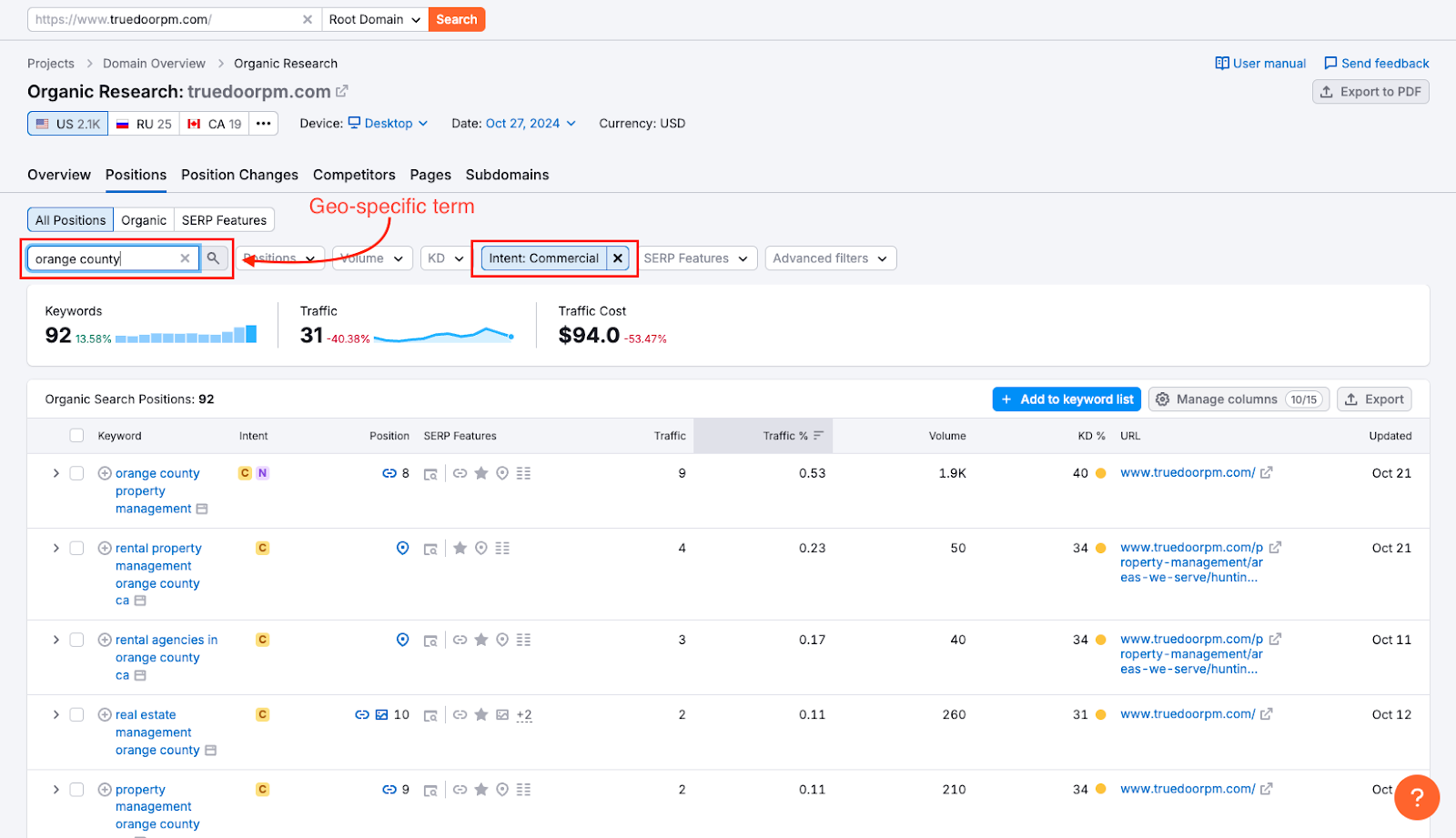

Hire Experts to Implement A Low-Hanging Fruit SEO Plan For Your Site
Finding and integrating low-hanging fruit SEO strategies for your digital marketing efforts can be tedious work. From researching low-competition keywords to optimizing your content by targeting striking-distance search terms, low-hanging fruit SEO requires time, effort, and specific skills for effective results. Fortunately, Rock Salt Marketing’s SEO specialists are experts in low-hanging fruit optimization techniques for businesses from various industries. We’ve worked with small mom-and-pop companies and Fortune 500 franchises to yield massive online results from our proven SEO strategies.
Our Utah SEO team creates optimized content, conducts exhaustive keyword research (including targeting low-hanging fruit search terms), manages business profiles, tracks performance, and reports on the success of our SEO efforts. If you’re looking for professional SEO help, including leveraging the power of low-hanging fruit optimization, Rock Salt Marketing is the SEO agency for you. Get in touch with our team to work with Utah’s leading digital marketing agency and start climbing the search results.




